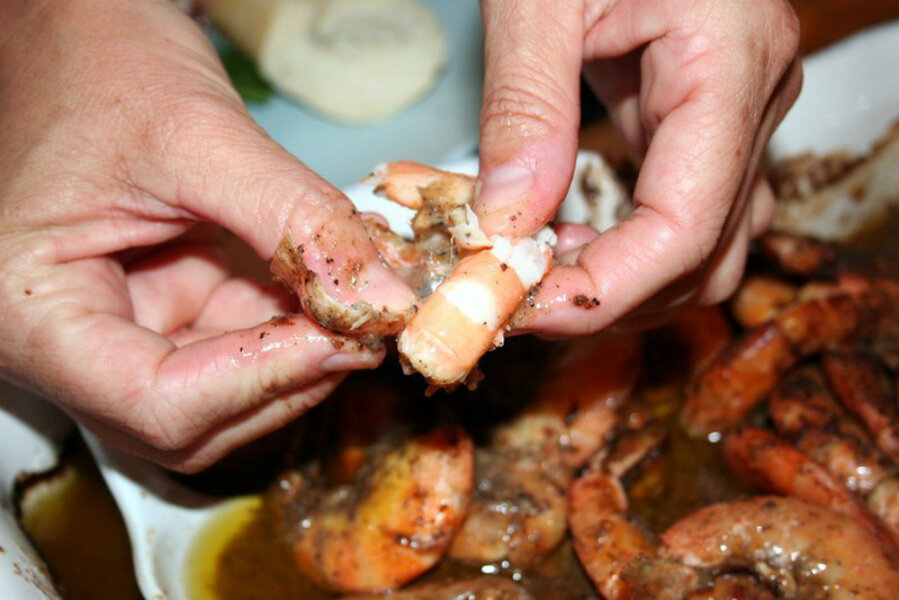New Orleans barbecue shrimp
In restaurants throughout New Orleans, you’ll find Barbecue Shrimp on the menu; some restaurants are famous for their version. It is not barbecue in the sense of the thick, red, sticky sauce you normally think of, and certainly not barbecue like we revere here in Memphis. No, it’s a buttery, peppery batch of slap-your-mama goodness, just calling out to a big group of friends. Around here, a local community cookbook published in 1971 included a recipe for New Orleans Barbecue Shrimp, and it was a staple recipe at many parties for years – football games, summer get-togethers and such. But, like many old stand-by recipes, it fell by the wayside, replaced by other, newer recipes that at the time probably included pesto.
I hadn’t thought of these shrimp in years, until last summer for a lake-house weekend, a friend made a batch for dinner. It was a great evening, multi-generational, parts of families that have known each other since God was a baby. Spread out around a long table, talking gossip and politics (loudly) and kids and memories and plans, overlooking the sunset across the lake, butter dripping down our arms and chins and shrimp shells overflowing from the bowls placed to catch them.
All this summer, I have been thinking about those shrimp, craving those shrimp, and just dying for a reason to fix some up, partly because they are just so good and partly because of the laughter and camaraderie that seems to go along with them. So on a recent return to the lake, with some of that same original group, I got my chance and cooked up a big ol’ batch of Barbecue Shrimp. After a crazy, hectic, long, sunny day on the water, swimming and skiing and even sailing, pulling this dinner together was easy. We sat at the table with big dishes of shrimp bathed in peppery butter, lots of bread for sopping up the sauce, a crisp green salad with watermelon and rolls of paper towels, laughing and joking and generally cutting up, even debating the best way to eat the shrimp. It was just like I remembered, and I can’t wait for the next Barbecue Shrimp excuse.
I’ve considered fiddling around with this, making my own Italian dressing, adding herbs or spices. But that would just be stupid. When something is this good and this simple, why mess it up. I just replaced the “oleo” with butter.
This is a meal best eaten with people you know well and like, because it gets messy, but I promise, once you’ve done this, you’ll be waiting for an excuse to do it again.
New Orleans Barbecue Shrimp
Yes, use the whole can of pepper and all the butter. That’s the whole point of the exercise. Use regular old Italian dressing, which I found surprisingly hard to locate among the balsamic vinaigrettes and sundried tomato dressings, but it’s there. And I always search for wild American Gulf shrimp.
1 pound butter
1 (16 ounce) bottle of Italian dressing
Juice of four lemons
1 (2 ounce) can of ground black pepper
5 pounds of uncooked shrimp, peels and tails intact
Good French or Italian bread for soaking up the sauce
1. Preheat the oven to 350 degrees F.
2. Melt the butter in a large saucepan then stir in the dressing, lemon juice and pepper. Stir well and heat through.
3. Place the shrimp in a large roasting pan or two casserole dishes – they do not have to be in one layer, as many as will fit in the dish with the sauce is fine. Pour the butter sauce over the shrimp and stir to coat. Place the shrimp in the oven and roast for 45 minutes (they can stay in a bit longer or happily sit for half an hour or so out of the oven if you get distracted with a beer).
4. To serve, either scoop the shrimp into bowls with lots of butter sauce, or place the dish directly on the table family-style for everyone to dig into. You will need to provide lots of paper towels or napkins and some vessels for the shrimp peels to be tossed in, and lots of bread for sopping up the amazing sauce.
Related post on The Runaway Spoon: Shrimp Creole






